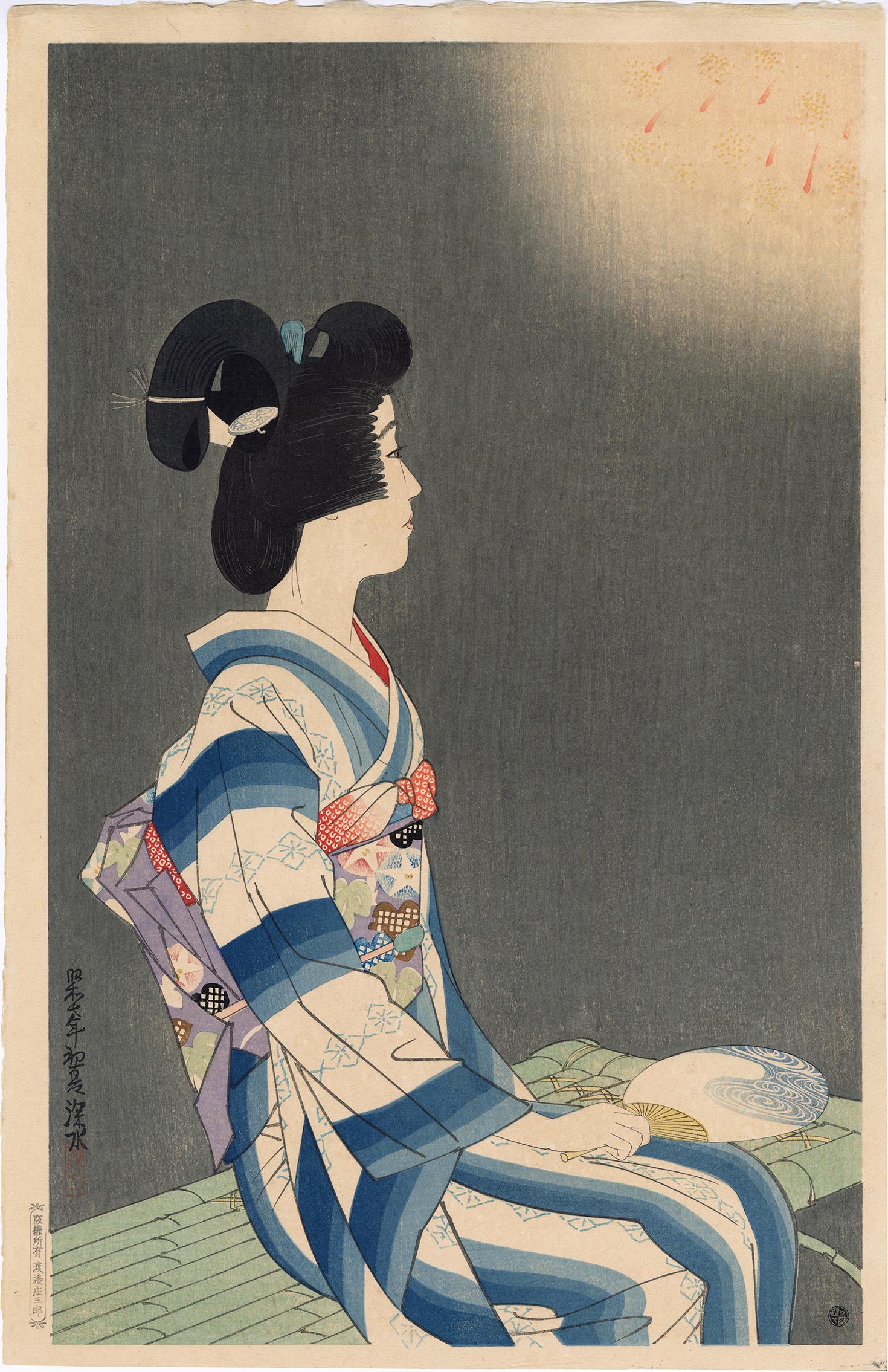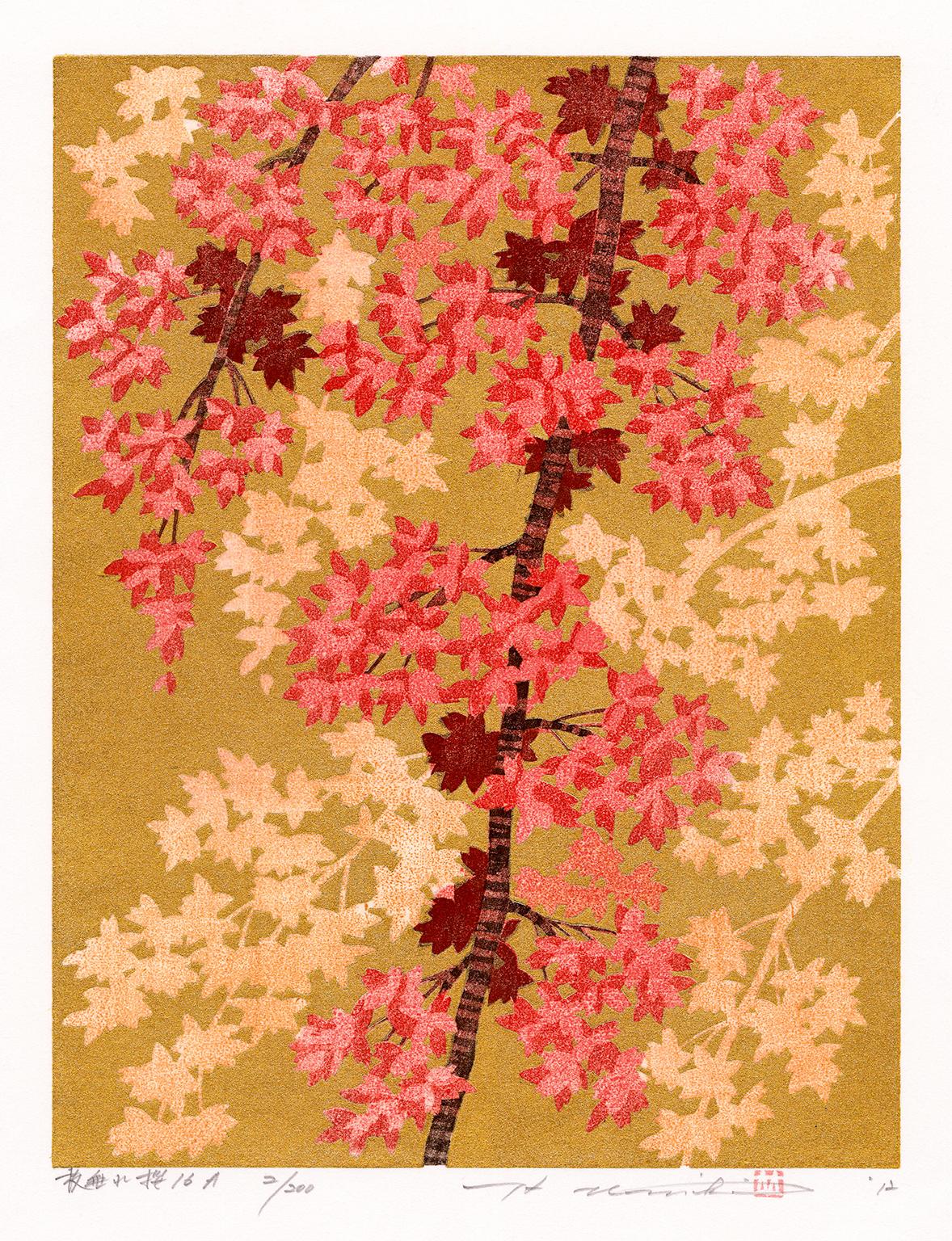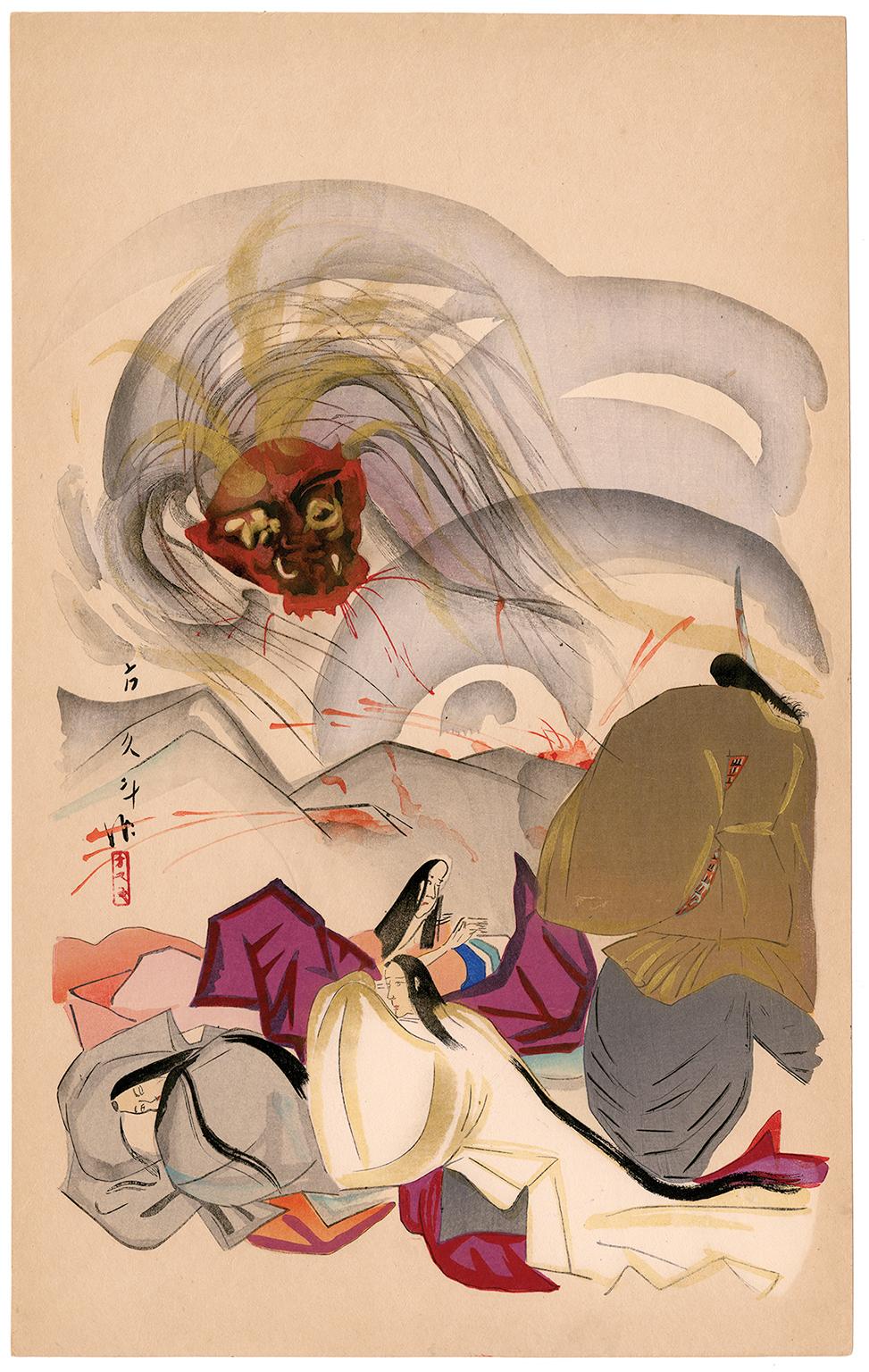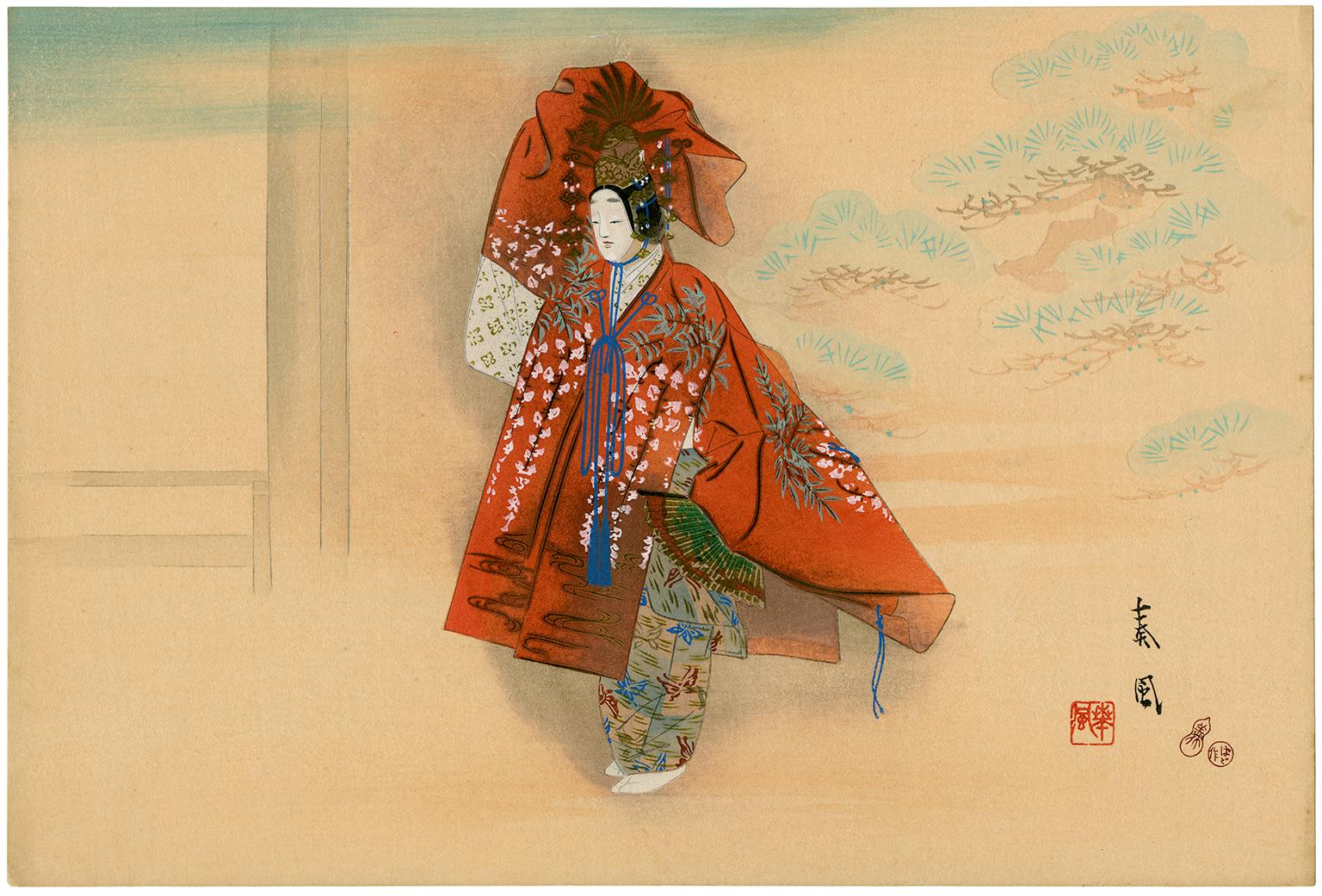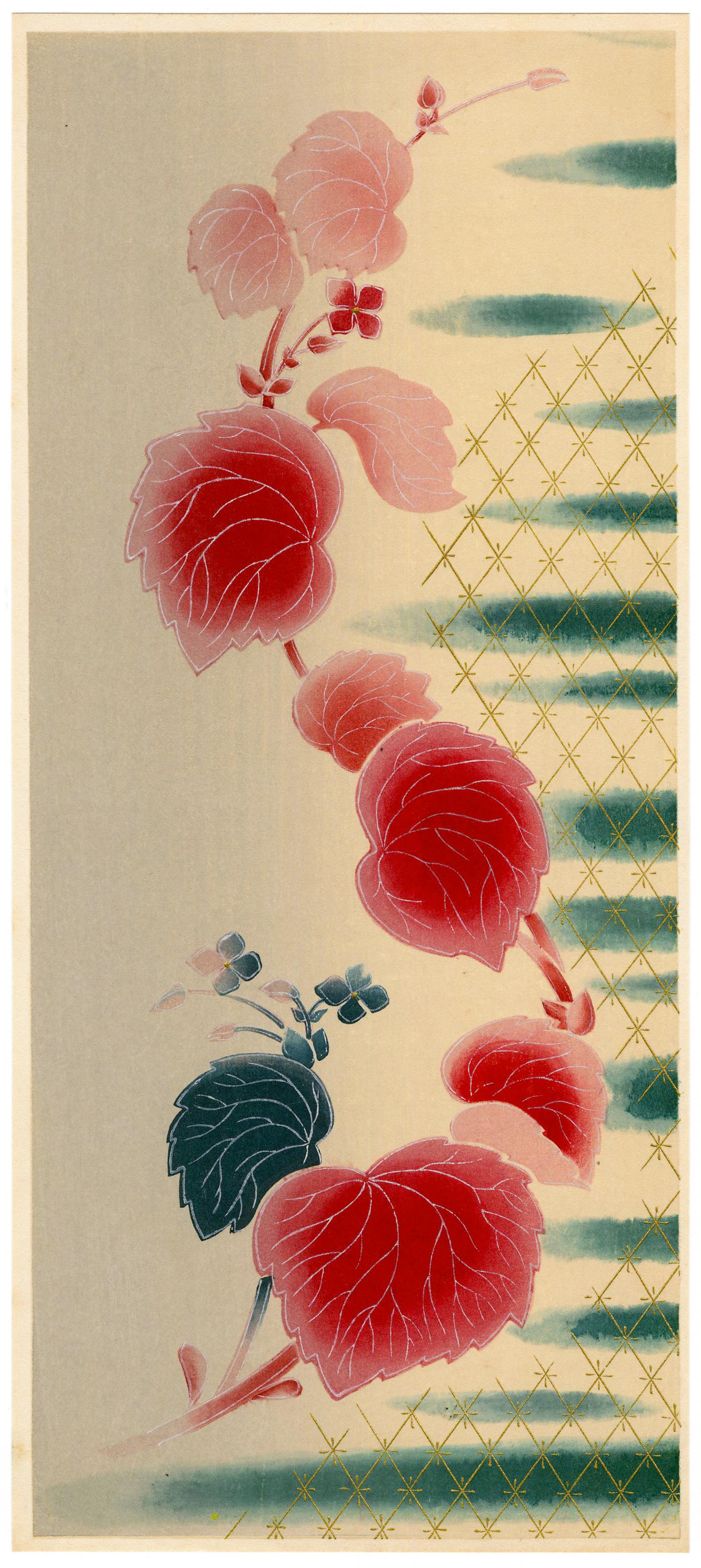Items Similar to 'A Very Funny Story, Mongols' — Mid-Century Woodblock Print
Want more images or videos?
Request additional images or videos from the seller
1 of 6
Paul Jacoulet'A Very Funny Story, Mongols' — Mid-Century Woodblock Print 1949
1949
About the Item
Paul Jacoulet, 'Une Histoire très Drôle, Mongols', color woodblock print, 1949. A fine impression, with fresh colors, on the artist's handmade, personally watermarked Japan paper, in excellent condition. Signed in pencil in the image, lower left, with the artist's red 'Ivy' seal. Carver Maeda Kentaro and printer Honda seals in the lower right margin.
Self-published, second edition 350; numbered 131/350, lower left, verso. Image size 15 7/16 x 11 3/4 inches (392 x 298 mm); sheet size 18 1/2 x 14 1/8 inches (470 x 359 mm). Archivally matted to museum standards.
An impression of this work is in the permanent collection of the USC Pacific Asia Museum.
ABOUT THE ARTIST
The Yokohama Museum of Art mounted an extensive exhibition of Paul Jacoulet’s graphic art in 2003, the first in Japan. Tai Kawabata, the award-winning staff reporter/writer for The Japan Times, wrote in his review of the show:
“Visitors to ‘The Rainbow Vision of French Ukiyo-e Artist Paul Jacoulet’ will not see traditional ukiyo-e subjects, such as landscapes or beautiful Japanese women. Instead, they will be struck by a large number of predominantly pastel-hued, though vivid — and often erotic — portraits of the indigenous people of Micronesia."
Jacoulet, who suffered from frailty and ill health, first visited Micronesia at his mother’s recommendation in 1929. From then on, until around 1937, he repeatedly wintered in the islands — at that time under a Japanese mandate. What Jacoulet captured in Micronesia was the transient beauty of a paradise on the verge of disappearing — and he used incredible craft and skill to create his stunning images. After the opening ceremony of the exhibition, Christian Polak, an expert on Jacoulet who contributed a biography of the artist to the catalog, summarized the artist’s technique: 'He used only pencils [to draw lines]. He had marvelous pencil lines — they are like Utamaro. His colors are fantastic — they are like Gauguin.'
While traditional Japanese ukiyo-e artists layered on colors by using 20 to 30 blocks per print, according to Polak, Jacoulet used as many as 200 different blocks to create a single print. Thus, his works are very much the product of collaboration between the artist himself and Japanese woodblock carvers and printers. Perhaps this explains why, despite a prolific output of drawings and watercolors, Jacoulet produced just 166 colored woodblock prints. Of these, only 26 deal with Japanese subjects. Among other subjects are Koreans in traditional dress, elderly Ainu people, Chinese beauties, and Western residents of Japan. Some 100 prints are displayed here.
Born in Paris in January 1896, Jacoulet arrived in Japan in September 1899 when he and his mother joined his father, Paul Frederic, who taught French at the School of Business (now Hitotsubashi University) and the School of Foreign Languages of Tokyo (now the Tokyo University of Foreign Studies). The young Jacoulet completed his primary and secondary education at the Tokyo High Normal School, where he was the only Western pupil. He also learned Japanese calligraphy and took private lessons in Western-style painting with Seiki Kuroda (1866-1924), a Japanese pioneer of the genre. He also took dancing lessons and studied gidayu (narrative chanting to the accompaniment of shamisen), at which he attained almost professional-level proficiency. Under Terukata Ikeda (1883-1921) and his wife Shoen (1888-1917), he also mastered the techniques of bijin-ga (paintings of beautiful women).
Around the beginning of 1915, Jacoulet started working at the French Embassy. In the following decade, he began to devote his energy to painting. Jacoulet’s first published prints, which appeared between 1934 and 1935, were 10 works grouped under the title “Genre Prints from Around the World.” The series comprised portraits of seven Micronesians, one Japanese, one Korean, and one French woman, and included his first color print, “Young Girl of Saipan and Hibiscus Flowers, Marianas.” This series was followed by numerous prints based on watercolors from his visits to Micronesia, Korea, and China.
In addition to Jacoulet’s woodblock prints, the current exhibition includes his Japanese paintings, drawings, and watercolors — the latter being shown publicly for the first time. Kiyoko Sawatari, who is the driving force behind the exhibition, examined more than 2,000 of Jacoulet’s watercolors and drawings at the artist’s Karuizawa studio in Nagano Prefecture. “Jacoulet is different from other painters of Japonisme, in that he became an artist in Japan,” says Sawatari. “His work is too complex and multidimensional to be subsumed under the simple phrase ‘a blending of Japanese and Western styles.’ “ That the works survived at all is thanks to Rah Yong Hwan, a Korean who served as Jacoulet’s assistant and secretary and later became a naturalized Japanese citizen, taking the name Hiroshi Tomita.
Just before the March 1945 Tokyo fire-bombing, Tomita and his three younger brothers transported Jacoulet’s works from his studio in Akasaka to Karuizawa where they remained until Therese, Tomita’s daughter, who was adopted by Jacoulet, took on the task of preserving his works after the artist’s death. Thanks to the devotion of a small number of enthusiasts, Jacoulet’s work survives today to be seen and appreciated by his worldwide admirers.
- Creator:Paul Jacoulet (1902 - 1960, French)
- Creation Year:1949
- Dimensions:Height: 15.44 in (39.22 cm)Width: 11.75 in (29.85 cm)
- Medium:
- Movement & Style:
- Period:
- Condition:
- Gallery Location:Myrtle Beach, SC
- Reference Number:
About the Seller
5.0
Recognized Seller
These prestigious sellers are industry leaders and represent the highest echelon for item quality and design.
Platinum Seller
These expertly vetted sellers are 1stDibs' most experienced sellers and are rated highest by our customers.
Established in 1995
1stDibs seller since 2016
256 sales on 1stDibs
Typical response time: 1 hour
Associations
International Fine Print Dealers Association
- ShippingRetrieving quote...Ships From: Myrtle Beach, SC
- Return PolicyA return for this item may be initiated within 7 days of delivery.
More From This SellerView All
- 'Rain at Shinagawa, Ryoshimachi' — lifetime impressionBy Kawase HasuiLocated in Myrtle Beach, SCA fine, atmospheric impression, with fresh colors; the full sheet, in excellent condition. Signed 'Hasui' with the artist’s seal 'Kawase', lower left. Published by Watanabe Shozaburo with the Watanabe 6mm round seal indicating a lifetime impression printed between 1945 - 1957. Archivally sleeved, unmatted. Image size 14 1/4 x 9 3/8 inches (362 x 238 mm); sheet size 15 1/2 x 10 3/8 inches (391 x 264 mm). An impression of this work is in the permanent collection of the Fine Arts Museum of San Francisco, Achenbach Foundation. ABOUT THE ARTIST “I do not paint subjective impressions. My work is based on reality...I can not falsify...(but) I can simplify…I make mental impressions of the light and color at the time of sketching. While coloring the sketch, I am already imagining the effects in a woodblock print.” — Kawase Hasui Hasui Kawase (1883–1957) is the most celebrated Japanese print designer of the shin-hanga ('new prints') movement. His prints, produced under the guidance and discerning eye of his publisher, Watanabe Shozaburo, represent the modern legacy of the renowned 19th-century Ukiyo-e masters Hiroshige and Hokusai. Hasui was able to evoke the fleeting beauty of Japan during the interwar period as no other printmaker of his time could. Hasui's work enjoyed huge popularity upon producing his first print in 1918. Watanabe recognized and developed the enormous potential of the American market, resulting in Hasui's prints achieving high prices at auctions in New York as early as the 1920s. After the Second World War, his prints became highly sought-after collectible works among the American occupying forces in Japan. Hasui designed more than 600 prints during the 40-year span of his artistic career, and in 1956, he was named a 'Living National Treasure' of Japan. Hasui’s woodblock...Category
1930s Showa Figurative Prints
MaterialsWoodcut
- 'Weeping Cherry 16 A' — Contemporary Japanese PrintmakerLocated in Myrtle Beach, SCHajime Namiki, 'Weeping Cherry 16 A', color woodblock print, 2012, edition 200. Signed in pencil with the artist’s red seal. Titled, dated, and numbered ...Category
2010s Showa Figurative Prints
MaterialsWoodcut
- 'The Spirit of the Wine' — Modernist Japanese Printmaking, 1920sLocated in Myrtle Beach, SCHokuto Tamamura (1893-1951), 'The Spirit of the Wine' (Shuten Dōji) - from Dai Chikamatsu Zenshu (The Complete Works of Chikamatsu)', color woodblock, 1923-26. Signed 'Hokuto'. A fin...Category
1920s Showa Figurative Prints
MaterialsWoodcut
- Hagoromo - NohLocated in Myrtle Beach, SCMatsuno Sofu (1899-1963), 'Hagoromo - Noh', woodblock print, 1937. Signed 'Sofu' with the artist's seal, lower right. A fine impression, with fresh color...Category
1930s Showa Figurative Prints
MaterialsWoodcut
- Japanese Kimono Fabric Design — Color Woodblock Print, c. 1930Located in Myrtle Beach, SCAnonymous, Japanese Kimono Fabric Design, color woodcut, c. 1930. A superb impression, with fresh colors, fine graduations, and metallic gold motifs, on ...Category
Early 1900s Showa Figurative Prints
MaterialsWoodcut
- 'Chion-in Temple Gate' from 'Eight Scenes of Cherry Blossoms' — Jizuri SealBy Hiroshi YoshidaLocated in Myrtle Beach, SCHiroshi Yoshida, 'Chion-in Temple Gate (Sunset)' from the series 'Eight Scenes of Cherry Blossoms (Sakura hachi dai: Sakura mon)', color woodblock print, 1935. Signed in brush 'Yoshida' and in pencil 'Hiroshi Yoshida'. A superb, early impression, with fresh colors; the full sheet with margins, on cream Japan paper; an area of slight toning in the top right sheet corner, not affecting the image, otherwise in excellent condition. Marked with a jizuri (self-printed) seal, upper left margin. Self-published by the artist. Image size 9 5/8 x 14 3/4 inches (444 x 375 mm); sheet size 10 7/8 x 16 inches (276 x 406 mm). Archivally sleeved, unmatted. Provenance: M. Nakazawa, Tokyo. Literature: Japanese Landscapes of the 20th century (Hotei Publishing calendar), 2001, May. Collections: Honolulu Museum of Art, Museum of Fine Arts, Boston. ABOUT THE IMAGE Located in Kyoto, Chionin is the main temple of the Jodo sect of Japanese Buddhism, one of the most popular Buddhist sects in Japan, having millions of followers. The Sanmon Gate, Chionin's entrance gate, standing 24 meters tall and 50 meters wide, it is the largest wooden temple gate in Japan and dates back to the early 1600s. Behind the gate, a wide set of stairs leads to the main temple grounds. ABOUT THE ARTIST Painter and printmaker Yoshida Hiroshi (1876-1950) is regarded as one of the greatest artists of the Japanese 'shin hanga' (New Print) movement. Yoshida was born as the second son of Ueda Tsukane in Kurume, Fukuoka Prefecture, a schoolteacher from an old samurai family. In 1891 he was adopted by his art teacher Yoshida Kasaburo in Fukuoka and took his surname. In 1893 he went to Kyoto to study painting, and the following year to Tokyo to join Koyama Shotaro's Fudosha private school; he also became a member of the Meiji Fine Arts Society. These institutions taught and advocated Western-style painting, greatly influencing Yoshida’s artistic development. In 1899 Yoshida had his first American exhibition at Detroit Museum of Art (now Detroit Institute of Art), making the first of many visits to the US and Europe. In 1902 he helped reorganize the Meiji Fine Arts Society, renaming it the Taiheiyo-Gakai (Pacific Painting...Category
1930s Showa Figurative Prints
MaterialsWoodcut
You May Also Like
- Beauty Enjoying Summer FireworksBy Ito ShinsuiLocated in Burbank, CATitle: Fireworks 花火 Series: The Second Collection of Modern Beauties (Gendai bijin shū dai nishū 現代美人集第二輯) Date: 1932 A young woman is shown enjoying the summer fireworks, her face shown in profile as she looks towards the display. She holds a summer fan on her lap, and her kimono features large blue stripes and is tied with a colorful obi that features a morning glory pattern. The summer evening sky is a soft grey rather than a deep black, perhaps reflecting the brightness of the fireworks. Numbered verso, from a limited edition of 250 prints. Condition: Excellent impression, color and condition. Publisher: Watanabe Shôzaburô Literature: See “All the Woodblock Prints of Shinsui Ito...Category
1920s Showa Figurative Prints
MaterialsWoodcut
- Thirsty: The Appearance of a Town Geisha - a So-Called Wine-Server - in the AnseBy Taiso YoshitoshiLocated in Fairlawn, OHThirsty: The Appearance of a Town Geisha - a So-Called Wine-Server - in the Ansei Era Color woodcut, 1888 Signed; Seal: Taiso (see photo) Plate 22 from the series "Thirty-two Aspects...Category
1880s Showa Figurative Prints
MaterialsWoodcut
- Morita Kanya XIII As Genta Kagesue in the play Genta KandoBy Natori ShunsenLocated in Fairlawn, OHMorita Kanya XIII As Genta Kagesue in the play Genta Kando Color woodcut, 1928 Signed and stamped middle right edge Natori stamp lower left image edge Series: Collection of Creative...Category
1920s Showa Figurative Prints
MaterialsWoodcut
- Junichiro Sekino Japanese Signed Limited Edition Print Girl Cradling Cat RedBy Junichiro SekinoLocated in Norfolk, GBPaper Size: 37.4 x 31.6 cm Image Size: 27 x 24 cm Print on paper, signed in pencil to the right, Edition in pencil 39/58. There is an artist water mark in the paper (see image) As S...Category
20th Century Showa Figurative Prints
MaterialsPaper
- Junichiro Sekino Signed Edition 39/58 Japanese Print Girl Cradling Red CatBy Junichiro SekinoLocated in Norfolk, GBPaper Size: 37.4 x 31.6 cm Image Size: 27 x 24 cm Print on paper, signed in pencil to the right, Edition in pencil 39/58. There is an artist water mark in the paper (see image) As S...Category
20th Century Showa Figurative Prints
MaterialsPaper, Etching
- Moscow, Russia Workers Woodblock c.1930s WPA era Woodcut Print Hand SignedBy Albert AbramovitzLocated in Surfside, FLSome of his prints were published by the WPA. it is a wood engraving signed in pencil. From a small edition. It measures 12 X 12.5 full sheet with margins. image is smaller. Albert...Category
1930s American Impressionist Figurative Prints
MaterialsWoodcut
Recently Viewed
View AllMore Ways To Browse
Chinese Woodblock
Large Japanese Woodcuts
Western Style Dress
Vintage Western Dress
Vintage Western Dresses
Japanese Woodblock Flower Prints
Traditional Secretary
Erotic Wife
Woodblock Woman
Rainbow Vintage Dress
Rainbow Dress Vintage
Chinese Woodcut
China Woodcut
Rainbow Women
Woman Dress Size2
Chinese Woodcut Print
Deals Vintage Dress
Woman Driving
